Kontakaiika
Kontakaiika (also known as Kontakeika) is a Greek village in the northwestern part of Samos, 5 km from Karlovasi. The village belongs to the prefecture of Samos. According to the 2011 census, the village has 962 inhabitants.
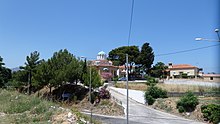
Kontakaiika | |
|---|---|
Village | |
| Κοντακαϊΐκα | |
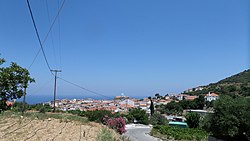 A view of the village Kontakaiika | |
 Kontakaiika Location in Greece | |
| Coordinates: 37°48′07″N 26°44′40″E | |
| Elevation | 150 m (490 ft) |
| Population | |
| • Estimate ({{{pop_est_as_of}}}) | 940 |
| Time zone | Eastern Standard Time |
| Area code(s) | +22730 |
Origin and naming
After the middle of the 15th century AD the island of Samos was abandoned by its inhabitants almost completely. But the misery and suffering had begun earlier. The raids of Turkish and Arab pirates had made life unbearable. The devastating pressures on the island's population have resulted in its gradual desolation.
Residents sought refuge on islands such as Mytilene and Chios, but also on the opposite coast of Asia Minor.
The abandonment of the island led the inhabitants who remained in it, to live on inaccessible areas, invisible from the sea side.
Crops were abandoned and the island now looked like a wild place with lush vegetation.After the middle of the 16th century, in the context of a broader policy for the Aegean, the Turks sought to repopulate the island from the descendants of the old inhabitants or from young people, completely foreign to the island, inhabitants.
Thus, Greeks from all over Greece began to arrive in Samos. From Mytilene, the coasts of Asia Minor, the Peloponnese, Chios and other places. One of these young inhabitants, according to Stamatiadis, came from the island of Kos, around 1750 AD. In "Samiaka" , Stamatiadis mentions the following: Kontakaiika and the best Kotakaiika, are located on a fertile hill 150 meters above the sea. According to tradition, in 1750 AD George Kotis came from Kos and after buying lands he started to cultivate them. Later, his sons married women from the nearby village of Fourni (today's Ydroussa), brought them to their father's estates, built their houses here and became the first inhabitants of the village to be named Kotakaiika or Kontakaiika with the addition of "n" when pronouncing of the word. The modern inhabitants, as far as the origin of the name of the village is concerned, mention Kontakis as the first inhabitant, others as someone from Kontakiotis, and others as agree with Stamatiadis point of view[1].[2]
Castle
As we saw earlier in the historical period, from 1475 to 1573 AD. the pirates carried out repeated robberies on the island. As a result, the island was almost deserted.The few remaining inhabitants had no hope of surviving living in lowland areas, visible to pirates. Thus was found the solution of the habitation of steep areas, invisible from the sea side. These places became known as Castles or Little Castles.Castles were created and inhabited mainly on the northern side of the island, such as those near today's Avlakia, near Vourliotes and near our village.
The main features of a Castle were about common to most of them. So we are always talking about steep, inaccessible places, with only one road leading there. Around them were built walls to protect the inhabitants, while in the main area there were reservoirs for rainwater, the huts of the inhabitants and a church.
Near the Castle there had to be arable land so that the inhabitants could produce mainly vegetables for their basic nutritional needs.
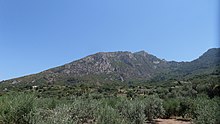
For their defense and timely notification in case of pirates, the residents had placed viglators. The vigilantes from their villas, their observatories, gazed at the sea all day and alerted in any way they could, mainly by lighting fires, so that the inhabitants could return quickly to the Castle and secure its usually strong and durable door.Those residents who were away from the Castle at the time were rushing to shelter in places they already knew and were destined for emergency shelters.
Kritikidis , in his treatise On the desolation and openness of Samos[3] states that 350 houses and 2 temples were built in Kastrovouni of Kontakaiika.
Kontakaiika is the possible capital of Samos at that time, as well as the seat of the Governor and the Bishop of the island.
Let's see what Stamatiadis says in his "Samiaka"[1] about the Castle of our village:West of Kontakaika and at an altitude of 950 meters rises Kastrovouni, at the top of which are preserved ancient reservoirs and ruins of walls and coves that testify that once there was a fortress here. Locals say the fortress was built during the years when the Genoese ruled the island. A relief depicting a man and a woman sitting on a stool opposite a tripod was also found in the area. Almost in the middle of the plateau that forms on Kastrovouni, the ruins of the church of Agios Nikolaos are preserved, for which the simplistic inhabitants narrate "many waves of ignorance and superstition.The existence of the Castle was not noticed by the pirates, until one day an elderly woman, a resident of the Castle, descended to the foot of the hill, in the current area of the Holy Trinity.The pirates arrested her there and after torturing her, they learned about the existence of the Castle and the road that led there, from the Royal Village.This was followed by a surprise attack by pirates and the destruction of the Castle.
Years later, Stamatiadis described the Castle of our village, the ruins of a second church, that of Agios Konstantinos, were also discovered. Many residents of our village go up to this place even today for a pilgrimage on Easter days where the churches of the Castle operate.
Historical events[4]
The contribution of the residents of our village to the historical events that occupied the island of Samos and Greece in general is memorable.
We have recorded historical testimonies about the participation of the village in the struggles of the homeland for three great struggles:
- The struggles of Samos to be liberated by the Turks and to unite with the rest of Greece
- The Balkan wars in Greece in 1912-1913
- The resistance to World War II
On June 6, 1834, the people of Samos sent two brave and proud letters to the Turks, making it clear that Samos would not submit to the sultan. The ardent desire of the island to unite with the rest of Greece, which had just been declared an independent state, is also co-signed by the residents of our village to Hasabey, commander of the Turkish fleet, who arrived on the island in April 1834.
During the Balkan wars of 1912-1913, the village gave many fighters, who for this reason started from the island and arrived in the long-suffering Macedonia, uniting their bodies with those of the Macedonian warriors. The Hero in the square of our village stood up in honor of the fallen Kontakiotes in the Struggle for the liberation of Macedonia.
In his column there are warriors of the village: Alexios Markou, Andreas Margaronis, Konstantinos Haritou, Stavros Karaggiaouris, Prodromos Kotakis, Nikolaos Pothas, Konstantinos Lambrou, Elias Christodoulou, Emmanouillon Antoniou, Antoniou Stanoulou, Konstantinos Hatzitoulis Elias Pothas.
During World War II, the island of Samos followed the fate of our conquered homeland. There were no battles on the island for its conquest. Historians typically report that not a single rifle fell, but was handed over to the Italian administration under unclear historical circumstances.
However, the winter of 1941-1942, with the island under Italian occupation, led the Samians to despair, with the deaths of the inhabitants from starvation that had no precedent. Hunger, disease and the sight of the Italian conqueror woke the inhabitants of the island.
So it was not long before a Greek Resistance was organized in the mountains of central and western mainly Samos, where the Karvounis and Kerkis Mountains could give the Greeks the coverage they needed. Our village was thus in the zone of the events of the Resistance. A group of fighters settled here and after fighting, the village was occupied by the Italian army. On September 8, 1943, the Allied Powers and Italy signed a truce in Samos.
The supervision of the island passes to the British, while the command of the Greek guerrillas again establishes in our village a company of soldiers as a militia, with the main purpose of preserving the order and security of the people.
However, the time for release had not yet arrived. On November 17, 1943, the Germans savagely bombed Vathi and Pythagorion.
The Greek troops, which consisted of soldiers of the Holy Corps and EAM guerrillas, along with a large population of civilians and a small number of English soldiers, leave the island and leave it in the hands of the Germans. The Germans arrested and executed Italian soldiers who were opposed to fascist Italy and had sided with the Greeks.
One such execution took place in Ag. Dimitrios in Kontakaiika. Finally, in September 1944, German occupation troops withdrew, and the islanders breathed a sigh of relief.
Demographics and settlements
The numbers speak for the history of the village and its settlements.
When one examines the historical presence of the village, one does not have the luxury of leaving out the important elements for the evolution of the population in the past decades and centuries that it discovers.
So looking for such data, we find the first record of the inhabitants of the village in 1828.
That year the village has a population of 272 indigenous people. Of these, 138 were men and 134 were women. At that time, 25 residents lived in the village, raising the total population to 297 people. 84 houses were built in the village and there was an olive mill and a mill.
Shortly before 1890, there were 806 permanent residents in the village, of whom 155 were men, 178 were women and 473 children, 258 boys and 215 girls. The village consisted of 176 families while the number of houses built was 188.
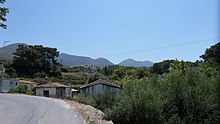
We draw important written information about the historical presence of the village from the official census of the inhabitants in 1920. This census is the first official one carried out by the Greek state on the island. The population of the Kontakaiiks was 1197, of whom 540 were men and 657 women. In addition to the main village, 14 settlements are mentioned in this census, which are:
- Saint Demetrius
- Saint Nicholas
- Thalassinides
- Kato Kalivia
- Koliobetsides
- Cosmasmades
- Houvardades
- Makraioi
- Macroglides
- Manoloukides
- Hatziantonides
- Hatzipanagiotides and
- Hatzistamoulides
And eight years after the 1928 census, in addition to the main village, 18 settlements are reported. The settlement of Makraioi is no longer mentioned, while the settlements appear:
- Karyotakides
- Kastanides
- Matsoukides and
- Chramides
The total number of inhabitants, according to this census, increased to 1365, of whom 680 were men and 685 women.
The next census on the island in 1940 shows 1464 inhabitants in the village, of whom 740 were men and 724 were women. Unfortunately, from this census onwards, no reference is made to the settlements of the village, so that today we know exactly the evolution of each of them. This year the village has the largest population in its historical course.
According to the 1951 census, the village has 1183 inhabitants, of which 552 were men and 631 women. A new statistic added is the population density per square kilometer. Thus, this year there are 147.88 inhabitants per sq. Km.
From the data we have for the censuses of 1961 and 1971, it is worth noting that the population of the village was 1092 in 1961 and 818 in 1971, respectively.
From the 1981 census we derive much more information about the village and the living conditions of the inhabitants. Their number is 825 for this year. The distribution of the population according to their age, in a sample of 670 people, shows that the majority of the population is between 19 and 64 years old (360 people), followed by the inhabitants up to 18 years old (180 people) and the inhabitants over 64 years old. (130 people). Of the same sample of residents, 540 are said to be at least literate, 20 are at least high school graduates and 50 are illiterate. In 460 normal houses in the village, 160 do not have electricity, 360 do not have a bathroom, 390 do not have central heating, 30 do not have a kitchen, 100 do not have water supply and 130 do not have sewerage.
The village occupies an area of 8,300 acres, of which 2,500 acres are cultivated areas, 4,300 acres are private pastures, 1,300 acres are forests and 200 acres are the area occupied by settlements.
During the 1991 census, the Statistical Service carried out a very systematic census and recording of the inhabitants and their homes, from which a lot of information emerges about the life of the inhabitants in the days close to our years.
The population in this census was 888, of whom 431 were men and 457 were women. The exact distribution of the population according to their age is as follows:
- 0-14 years: 192 people
- 15-29 years: 185 people
- 30-44 years: 142 people
- 45-64 years: 219 people
- 65 years and over: 150 people
Of the 888 residents, 284 were financially active, of whom 151 were self-employed and 105 were employed. The distribution of the economically active population by profession was as follows:
- 100 were engaged in agriculture, animal husbandry and fishing.
- 51 was involved in construction.
- 43 engaged in trade, repairs, hotels or restaurants.
- 26 were involved in the manufacturing industries.
- 24 residents worked in various services.
- 20 residents were involved in transportation, storage and communications.
- 2 residents are reported as young.
- 1 resident worked in electricity, gas and water service, while
- 17 residents did not declare economic activity.
Apart from the number of inhabitants and the data concerning the living potential of the village, we also have rich data for the households and the buildings of the village.
318 households were recorded, of which:
- All had a kitchen
- 313 electric
- 173 phone
- 219 bath
- 314 water supply
- 31 central heating
- 235 had a toilet and
- 225 were drained
During the 1991 census, the buildings of the village were also counted. 709 buildings were counted, of which:
- 483 were homes
- 15 churches and monasteries
- 3 were hotels
- 10 factories and workshops
- 1 school building
- 16 stores and offices
- 13 car stations (parking) and finally
- 168 buildings declared for other uses
As for the year of construction of the buildings recorded, most of them were built during the years 1919-1945, followed by the period between the years 1946-1960, then the buildings built before 1919, buildings between the years 1971-1980 and finally buildings between the years 1961-1970 and finally buildings built during the period 1981-1991.
As it is obvious from the antiquity of the buildings, the materials used for the construction of 411 of them were stone, in 245 buildings bricks and concrete were used, while the rest of the buildings were made of concrete blocks, wood and other materials.
Finally, according to the recent 2001 census, there are 906 inhabitants in the village. The data that will emerge from this census will be very rich (... AWARD 2001 and 2011 ELEMENTS ....)
Most of the settlements in the village have now been abandoned, others have now been integrated with the main village. There are also cases where some new houses have been built near the ruined houses of abandoned settlements. The reason for their abandonment should not be sought in the reduction of the population, for the simple reason that the population of the village has not decreased over the decades, but not to the extent that the rural population has decreased in the rest of Greece.
It is enough to look at the census of 1920 (1197 inhabitants) and the recent one of 2001 (906 inhabitants) (DECISION 2011) To understand the constant presence of the inhabitants in the village. The reason for the creation of the settlements was mainly the need of many residents to live close to their crops, in order to facilitate as much as possible their already exhausting daily life.
However, the new cultivation methods and the use of the car for the transport of products and transportation eliminated the need for the presence of the residents close to their crops.
The new houses built along the road leading from the settlement of Agios Nikolaos, located at sea level, to the main village, now give the image of a village quite scattered but united.
Irrigation and water supply
Throughout the village and its settlements there were once only four fountains from which the inhabitants carried daily the water they needed to drink themselves, to wash their clothes and to water the pets they had. Of these fountains, three were in the main village and the fourth in Kato Kalyvia.
All the residents of the village, aged from year to year, have exactly the same expression when someone asks them about what life was like in the village in the past. An expression reveals mixed feelings.
On the one hand nostalgia for the past and on the other pain, fatigue, poverty and hardship. The eyes, in remembrance of old times, as if smiling in pain. It's as if these people are so tired that they carry this fatigue in them even today, after so many years. Those who were far from these fountains tried to meet their water needs either from their own wells or by walking the entire distance, several times during the day.
Washing of clothes, carpets and bedding was done on the spot, in the area where each fountain was located, as any other solution was impossible. It is easy to understand that the hygiene conditions were tolerated only by the superhuman efforts of the women of each house.
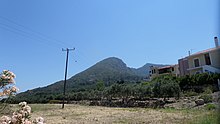
The huge needs of the village for water, for domestic use and irrigation of the fields, remained untreated for many decades, until the inhabitants saw the specter of economic decline to seriously threaten the survival of their village. Concerns and discussions among residents have begun to take shape in the early 1950s.
After certifying the source that could meet the needs of the village in irrigation and after examining the possible ways for this water to reach the village, the actions of the residents to approve the project by the Greek state officially began on January 2, 1953. The president of the community at that time, Ioannis Houvardas, pressured and claimed with all his might to include this project in the projects planned for the prefecture of Samos, planned by the Greek state.
So, about five years later, on June 9, 1957, the project finally began. Everyone contributed to the completion of the project. On the part of the residents, everyone. Men and women, children, adults and the elderly, each as he could put his little stone to make the dream come true. The project was carried out exclusively by manual labor of the residents, as neither the means nor the inaccessible area, in which the works took place, allowed the use of a car or other machine. The breaking of stones, the creation of gravel, the transport of sand and cement, wood and iron, everything was done manually and the transfers were made only with animals. If one considers that the source is 7 km away from the village, one can easily imagine the titanic struggle of the inhabitants. Less than a year after the start of work on November 9, 1958, the project was completed. From the area "Paleomylos" the water flowed in the ditch that was created and reached the village, where it was united with the tears of joy of the residents.
There is evidence today that on the day the water passed through the village, many women were sitting and stroking its surface as it flowed, not believing that the dream of decades had come true.
About five years later, in the early 1960s, water supply to the homes was completed. The president of the community at that time was Nikolaos Triantafyllou. That drinking water came from the Hasanaga spring, which is located in a location very close to the border of the village of Ambelos.
The arrival of water changed the course of the history of the village. If the village is prosperous today, if the inhabitants show no willingness to emigrate to a large urban center, they owe it to this water, which since 1958 has been irrigating the fields of the region inexhaustibly. From that year, the cultivation of the poor until then changed.
Presidents since 1953
Undoubtedly, the people who served as presidents of the village in the past decades have undoubtedly made an important contribution to the development of the village. Researching community records is a persistent effort, as one has to check the signatures that exist after each entry in the records books to find out who the village president was at any given time. If one were to make a reference to the social contribution of each president, one should state exactly what each of them did or should avoid any reference so as not to offend some of them.
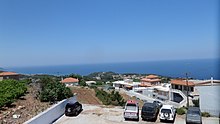
Indicatively, we may have to mention some important projects that took place in our village:
- Irrigation work in the 50s.
- The water supply project of the village in the ‘60s.
- The construction of the community store in the ‘70s.
- The works for the sewerage of the village, the asphalting and cement paving in the village in the ‘80s.
- The reform of the primary school, the connection of the sewerage with the biological treatment of Karlovasi.
- The construction of the village stadium in the ‘90s.
Naturally, many of the works that take place in one place are not done overnight. Some of them are charged to a president, many times they have started from a previous one. The social reality of the village is in constant evolution and sequence of events. What is certain is that with the action of all the presidents, they can now proudly boast that it is a village that provides the safe conditions to keep the residents tied to it.
The following are the presidents of the village from 1953 until today:
- 1953-1959 Ioannis Houvardas.
- 1959-1959 Angelis Vassiliou.
- 1959-1961 Nikolaos Dimitriou.
- 1962-1967 Nikolaos Triantafyllou.
- 1967-1971 Lykourgos Archontidis.
- 1971-1974 Nikolaos Kondylis.
- 1975-1982 Dimitrios Makridakis.
- 1983-1991 Dimitrios Kosmas.
- 1991-1998 Andreas Stasinis.
- 1999-2002 Evangelos Charilaou.
- 2003-2006 Evangelos Charilaou.
Primary school[5]
According to the London Protocol, Samos was declared a hegemony. The reign of the island lasted from 1834 to 1912. The first ruler of Samos, Stefanos Vogoridis, sent his Commissioner Alexios Fotiadis to proclaim the work of the Second General Assembly of Samia on 5-2-1837. At this Assembly, it was decided to establish five Greek Schools on the island:
- In the Port of Vathi
- To the Vourliotes
- In Karlovassi
- In Marathokampos and
- In Hora
Looking for the exact year of establishment of our school, we were unable to find sufficient information.
At the Assembly of 1851 it was decided to establish 23 Mutual Schools, which do not yet include the school of the Kontakaiika. Attendance at these schools was optional and lasted four years. At the Assembly of 1852, the qualifications that teachers would teach in villages should be determined. They had to:
Be able to read freely, seamlessly with ease and emphasis.
Know the four arithmetic operations and fractions.
Explain the sacred catechism.
Be calligraphed.
Express their ideas correctly.
Know grammar, phonetics, music and teaching methods.
However, things in the Education of Samos for many years did not go well at all.
Ep. Stamatiadis, as an education supervisor, wrote a report in 1874 stating the miserable situation of most schools, the constant absence of students, the lack of utensils and supervisory tools, and the mediocrity of most teachers. Since 1875, the Ervartian method has been abandoned and introduced into the schools of Samos. In the examinations given by the teachers of the island in 1882, in order to check their teaching competence, three teachers from Kontakaiika are mentioned:
- Dimitrios Ioannidis
- Stamatios Kotakkis
- St. Triantaphyllides
all rated "Very Good".
The first reliable information we have about the appointment of a teacher in Kontakaika is in 1886. In that year, after examinations given by the island's teachers in order to check the assimilation of the new Ervartian teaching method, one of the 30 successful teachers, Arist. Dimitriou, is appointed a teacher in Kontakaiika with a salary of 200 grosis. The school was one class with only one teacher.
On 11-11-1912, Samos declares its Union with Greece. Its schools are now subject to the laws and regulations of the Greek State. Attendance at school is now mandatory, teachers, from 1934 onwards, must study at the two-year Pedagogical Academies and schools now operate on the basis of the Greek State Curriculum. Educational things are changing a lot. Teaching becomes less oppressive to the student, teachers are trained and trained in pedagogical issues more systematically, the student comes in contact with the letters in a more effective way. In 1915, Ioannis Sidirourgos and Charalambos Theodorou were appointed to Kontakaiika with the rank of Tertiary Undergraduates with a salary of 55 drachmas. We have very important data for the operation of the village school from 1930 until today, thanks to the textbooks that are preserved intact in the school archive. Examining this material, one can gather very important information, not only about the operation of the school but also about the whole social spectrum of the village during the decades of the 20th century.
During the 1930s and 1940s, the average number of students was 222 per year, the highest number in 1932-1933 with 234 students and the lowest in 1930-1931 with 192 students. From 1930 to 1935 the school seal reads: "Full Primary School of Kontakaiika". Since 1936 the seal has been changed to: Primary School of Kontakaiikon of Samos. Kingdom of Greece .
During the 1940s-1950s the average number of students was 208 students per year, the highest number in the year 1940-1941 with 249 students. For the turbulent 1940s, various data emerge from the study of the archives. During the year 1942-1943 and 1943-1944 there are no indications of the operation of the school, as the books of the school show a gap in the specific point. The same happens during the years of the 1945-1946 civil war and 1946-1947. From the year 1948-1949, when the student register began to be filled in again normally, in the column where the profession of father of the students is written, we now find very often the words orphan as well as the word disabled.
During the 1950s, the average number of students was 177 students per year with the highest number in the year 1950-1951 with 193 students and the lowest number in the year 1958-1959 with 162 students.
During the 1960s and 1970s, the average student was 108 students per year, with a higher number in the year 1959-1960 with 153 students and a lower number in the year 1967-1968 with 94 students. During this decade, the Night Primary School of Kontakaiika also operated.
The Night Primary School was created to meet the educational needs of students who during the post-war period and during the Civil War in our country were far behind in school lessons or did not attend at all. The Students' Register Book shows that this school operated during the years 1962, 1964 and 1965, while for the year 1963 there is no evidence. The average age of the students who attended the Night School classes was 17 years. In 1962 the number of students at the Night School was 24, in 1964 17 and in 1965 the number of students was 13.
It is worth mentioning that between the years 1963 and 1964, the way of writing the name of the village in the official documents of the school changes. From Kontakeika it becomes Kontakaiika, as it remains to this day. The paradox is that the renaming to "Kontakaiika" was officially done by the Greek state much earlier, between 1928 and 1940. This is evident from the official censuses of the Greek state. While in the census of 1928 the village is written Kontakeika in the 1940 census it is written Kontakaiika.
However, Kontakeika still prevails today in many cases of use of the name and in official documents concerning the village. Studying the school's archives from 1977 to the present is very difficult, as strange as it may seem. And yet since 1977 the textbook has been abolished, students enrolled in the school since that year are enrolled without a year break in the Student Register and it is very difficult to clearly see how many students attended the school each year.
For the years 1970-1977, we have an average number of students of 90, with a higher number in the year 1970, 101 students and a smaller number in the year 1976, 78 students. So making a time jump, the only thing we know for sure is that during the school year 2002-2003 our school has 54 students.
If one compares the average of the 1960s-1970s with 108 students and students in 2002-2003, 54 students, one can easily see the reduction in students by exactly half. A conclusion that should clearly worry the village and the future of the place.
As far as we know from the school records, school principals from 1930 until today were:
- George Christodoularis 1930-1950.
- Tsakalias Petros 1950-1953.
- Perris Antonios 1953-1971.
- Paraskevi Antonia 1971-1972.
- Aligeorgiou Maria 1972-1973.
- Paleokastritis Alkiviadis 1973-1974, 1976-1979, 1981-1983. Konstantinidis Ioannis 1974-1976
- Louizou-Dadaou Maria 1979-1981.
- Triantafyllou Konstantinos 1983-2003.
In 1974, 52 Standard Training Centers were established in various cities in Greece. Kontakeika was part of the Karlovassi Training Center and thus began training in machine embroidery and standardization of agricultural products.
From the school year 1978-1979, the operation of the Kindergarten of the village started with 23 children that year. Kindergarten teacher and Director of the Kindergarten was from the first day until 2003 (?) Mrs. Angeliki Kotaki. In 2003, 14 students attended kindergarten classes.
In 1996, a major move was made to renovate the school building. At the initiative of the Principal of the school, Mr. Triantaphyllou Konstantinou, a fund was secured for the construction of four new halls in the courtyard of the school, which was purchased by the individual to whom it belonged. Valuable helpers in the effort were the then Prefect of Samos, Pythagoras Vardikos, the President of the Kontakeika community, Stasinis Andreas.
From that year, 1996, the school was upgraded from a three-seater to a four-seater and from 1999, to a six-seater Primary School. A few years later, in 2000, with the contribution of the then Prefect of Samos Thalassinos Thalassinos and the Mayor of Karlovasi, Lymperis Panagiotis, the money was secured for the reconstruction of the old school, which had deteriorated over the decades.
Churches and chapels[6]
Undoubtedly, the churches and chapels undoubtedly occupy an important place in the buildings of the village. One would even say that it may be disproportionately large in relation to the number of inhabitants. What is certain is that their existence testifies to the intense religious feeling that the village breathes. In fact, many are historic buildings of exceptional style for the whole island. Some brief information about the churches and chapels of the village are as follows:
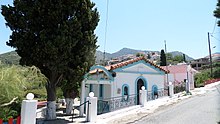
Church of the Assumption of the Virgin Mary
The Church of the Assumption of the Virgin Mary is the main church and is located in the center of the village.
The foundation stone of the church was laid in 1902 and the inauguration took place in 1917. The first to work on the construction of the church was the resident Ioannis Papakonstantinou, who made a fundraiser in order to gather the necessary expenses for the construction.
The reconstruction of the Holy Temple was done only in the summer period in order to achieve the correct extraction of the materials, maltese stone and sand, from the dams of Savoura Rachi area, as well as from the church property in Vrachoulia area, where the village stadium is located today.
The bricks that were used were made and baked in a kiln in the style of the time.
In the process of construction, all the residents of the village helped with personal work, transporting stones and bricks with the means of transport of the time, donkeys and carriages slid by animals. In fact, many residents carried on their shoulders that they could use materials or make shapes on the stones, while also making the bricks that were considered necessary. The contractor of the construction was Elias Lioridis, from the village of Platanos in Samos, while the craftsmen came from Karpathos. The same craftsmen must have built the chapel of St. Dimitriou and the Holy Cross of Kontakaiika, as the style of the buildings bears many similarities.
Agios Dimitrios
The church of Agios Dimitrios is located in the homonymous settlement of the village, next to the main road that connects Karlovassi with Vathi. The temple is built in the style of Byzantine domed crosses. It was built around 1902, as evidenced by the style of the building, by the same Carpathian craftsmen who built the church of Panagia in the village.
The church is a miniature of the central parish church and is a pole of attraction for tourists heading to Karlovassi.
It is not uncommon for tourists to stop for a while to photograph the beautiful temple.
Regarding the construction of the church there is the following myth:
Two little girls were grazing goats in the area where the temple was later built. One of the flocks of the herd left the rest of the herd each time and went to the specific spot to graze. When one of these little girls went to get the goat, she found a small stone icon of Agios Dimitrios.
It is even probable that in the area there used to be a ruined temple in honor of the Saint, where it is still located today.
Agios Nikolaos
The church of Agios Nikolaos is located in the homonymous settlement of the village, in the area of Limanaki of Agios Nikolaos. It is part of the holy monastery of the Prophet Elias Karlovassi and was built around (1500 AD) by Saint Paul of Latin, who came from the Lovers of Central Asia. The architectural style of the temple ranks it among the single-aisled basilicas.
Specifications in the interior of the temple are similar to those of the Church of Agios Ioannis located in Mytilinioi, Samos.
Unfortunately, inside the temple, many alterations were invited from newer interventions to the large narthex, the iconostasi, the floor and the dome.
Prophet Elias
The temple of the Prophet Elias is located in the settlement of Koliabetsides. The Beautiful Gate of the Temple is a gift from the Tanners as the Prophet Elijah is their patron saint.
The temple is decorated with beautiful images and on its feast there is a big summer festival.
Agios Dimitrios
It is located in the area of Kokkinos Vrachos. In the church there are many old Byzantine icons and they are owned by Myrsoula Tsiliri.
Transfiguration of the Savior
In the settlement of Kato Kalyvia is the Church of the Transfiguration of the Savior. The grace of St. Barbara is also celebrated in this temple.
Temple of the Holy Cross
This temple is located in the area of Kato Kalyvia. It is built of stone, has beautiful old images inside and is of royal style.
St. Anna and All Saints
It is owned by Mr. Emmanuel Markos and is located in the Savoura Rachi area.
Income of the Virgin Mary
Today's church is a restoration of an older building from 1950. It was renovated with the help of all the villagers and is a popular place of pilgrimage.
Saint George
This temple is not preserved today. In the past, it was located where the village square is today. Even today one can see a small part of the Holy Step.
The church was demolished in 1924, and there must have been a cemetery next door, as evidenced by various bones found there during the work that was done to shape the square.
Agioi Anargyroi
The church is located in the area of Makroglides and is owned by Ioannis Triantafyllou.
Agios Ioannis Theologos
It is located in the area of Vouno. In the past, there was a small church in this place, which was later renovated. Unfortunately, the temple was used for animal encampment during the Italian Occupation.
Saint Nektarios
Cemetery and pilgrimage.
The church was inaugurated in 1967 and holds part of the Holy Relics of St. Nektarios, which is lit on the day of the feast of the Saint.
St. Catherine
It is owned by G. Sarantos. It is located in the area of Thalassinides.
Cultural associations
- AMKE Arts & Culture Photo Gallery
- APSES of Pythagoras
- Association of Volunteer Firefighters
References
- Σταματιάδης, Επαμεινώνδας Ι (1862). Σαμιακά ήτοι ιστορία της νήσου Σάμου από των αρχαιοτάτων χρόνων μέχρι των καθ ημάς. Τόμος πρώτος / υπό Επαμεινώνδου Ι. Σταματιάδου. Αθήνησι: Τύποις Π. Α. Σακελλαρίου, 1862.
- Κρητικίδης, Εμμανουήλ (1982). Τοπογραφία αρχαία και σημερινή της Σάμου. Αθήνα: Βιβλιοπ. Νότη Καραβία.
- Κρητικίδης, Εμμανουήλ (1985). Πραγματεία περί της ερημώσεως και του συνοικισμού της Σάμου. ΑΘΗΝΑ: Βιβλιοπωλείο Ν.Δ. Καραβία.
- Ζαφείρης, Γιάννης (1962). Η Κατοχή Και Η Εθνική Αντίσταση Στη Σάμο 1941 - 1944. Αθήνα.
- Διακογιάννης, Παύλος (1989). Η παιδεία στη Σάμο : Από την Τουρκοκρατία μέχρι σήμερα. Αθήνα: Σύλλογος προς Διάδοσιν Ὠφελίμων Βιβλίων.
- Παπαϊωάννου, Κωνσταντίνος (1997). ΕΚΚΛΗΣΙΕΣ ΚΑΙ ΜΟΝΑΣΤΗΡΙΑ ΤΗΣ ΣΑΜΟΥ. Σάμος: Πνευματικό Ίδρυμα Σάμου "Νικόλαος Δημητρίου".
External links
https://www.samos24.gr/?s=%CE%A6%CF%89%CF%84%CF%8C%CE%BD%CE%B7%CF%83%CE%BF%CF%82
https://www.samos24.gr/?s=%CE%99%CE%B4%CE%B5%CF%8C%CE%B4%CE%B5%CE%BD%CF%84%CF%81%CE%BF
https://iake.weebly.com/praktika2016.html
https://www.statistics.gr/el/statistics/-/publication/SAM03/1991
https://www.statistics.gr/el/statistics/-/publication/SAM03/2001